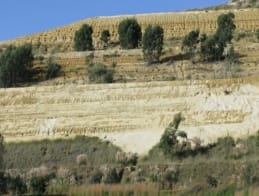Poison or Prophylactic?

This mine dump is much bigger than the ones in Rhodesia but you get the idea. Pic from: http://memorablemeanders.
Poison or Prophylactic?
Africa was full of disease of one sort or another. My father was always busier than he wanted to be. Malaria, hookworm, round worm and tapeworms of various sorts, tick bite fever and yellow fever could be problems amongst the white community. Bilharzia was prevalent amongst the outdoor types who contracted it at one time or another from the local rivers. The treatment was twenty one consecutive days of antimony shots. They were painful. Dad carried the necessary supplies in his lunchbox medical kit and dispensed on his rounds in the evenings if a patient could not make it to the surgery for one reason or another.
A Poison or Prophylactic?
The Campbells and Austens were of pioneer stock and were a tough bunch. Linda (Twiggy) Campbell was both a Campbell and an Austen. She got her own back after my Dad had made his last house call on Selous Avenue to give her a penicillin shot for jaundice. She shot him with her catty (catapault made out of a forked stick and bicycle tire strip). She relates “maybe if I had known he was going to later give me a one-for-luck Bill Harris (bilharzia) shot, I would have saved the pebble and catty for that, but I tell you what, those antibiotic shots hurt much more than the bilharzia shots.”
But some people seemed immune to bilharzia. As much as Keith Keitzmann swam in the rivers as a boy and subsequently tramped through the rivers during the war, he never got it. He put it down to the Roasting Plant and the 40 tons of arsenic it produced a month, a byproduct of gold production, a business subsidized by the Government. It was used for cattle dipping. Keith’s house was in a direct line with the smoke stack and the prevailing wind. They didn’t even have an ant on the property! His Dad had problems where his glasses sat on his nose. Their cross Dachshund/Pekinese’s paws in winter would be eaten up from arsenic deposits on the ground requiring little socks to protect her feet.
Errol Candy remembers you could taste the bitterness and it would make you cough if it blew over the house. He rescued a distressed cattle egret that had obviously flown through the smoke and crash landed in their yard. After a few day of rest it recovered and he released it, after a peck on the nose as a thank you.
Yearly, arsenic levels were taken of the workers in the plant, and after Derek Fullwood’s arsenic level increased to an ‘unsafe’ level he was kept from work for a period of time. Jock Nimmo had a permanent rash on his face. Joy, Jock’s wife had Cushings Disease and Leslie Candy developed it later in life.
My lasting memory of the Roasting Plant, as I bumped around with my Dad on the potholed dirt roads there doing house calls, is that everything associated with it had a greyish cast to it. The plant itself was coated in dust, the rocks around had little white spots, the gardens struggled, smothered in a grey powder. But there were exceptions. Mrs. Candy got a load of topsoil and grew a beautiful garden.
The trees around the Keitzmann house had loads of mangos and guavas. He believes his endogenous arsenic and the copious supply of fresh fruit picked from their own trees protected him from some of Africa’s endemic diseases. He’s still doing open water swims in New Zealand! Everyone seems to have survived to a ripe old age.
There was mercury in the amalgamation plant and cyanide in the mine dumps the children rode through on their way to Junior School. After school the dumps beckoned to be explored with boys like Richard Paxton…only a goody–two-shoes could resist all those crevices and mounds. But that’s another story…
Thanks to Keith Keitzmann and the Candy family for insights into the Roasting Plant as well as Linda Ihle and http://memorablemeanders for the picture.
